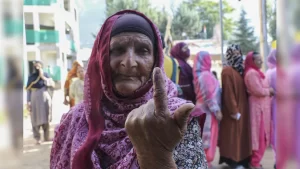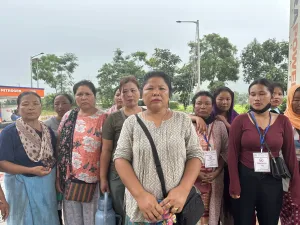In the Line of Fire: How Women in Kashmir Navigate War, Memory and Survival
Home is a fragile and tenuous idea for many Kashmiri women who live in vulnerable districts that can be shelled out of existence in seconds
- Safina Nabi
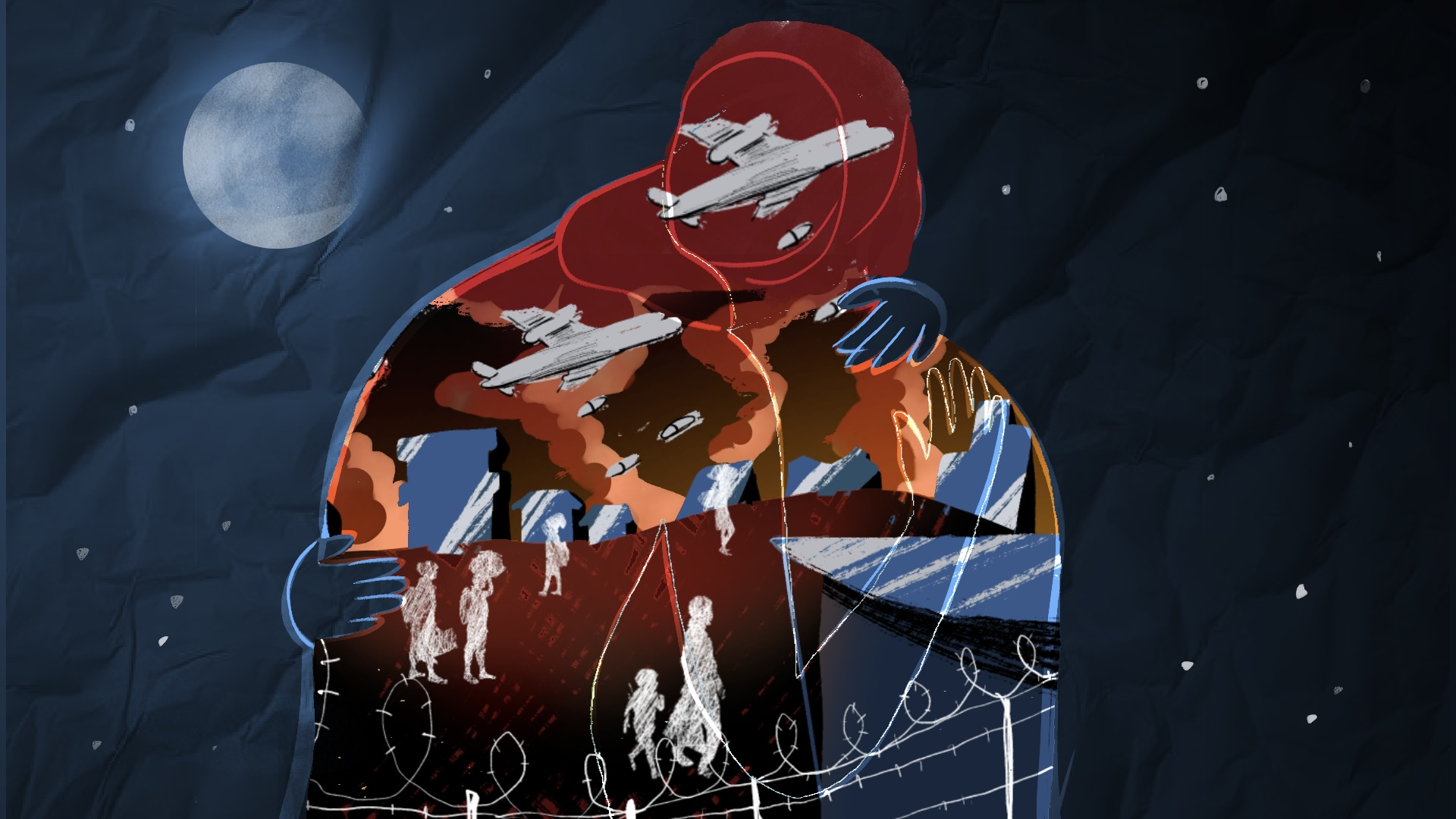
Just 10 minutes before Kalgi, a village in Uri, was hit by a shell after tensions escalated between India and Pakistan during Operation Sindoor, Zahida Bano had managed to escape her family home with her 16-day-old baby. Her home is just 10 km east of the Line of Control and it was 2 am.
Along with her family of 32, Zahida sought refuge in a bunker they had built in their backyard. Measuring 10×8 feet, it was the only bunker in the village. It took them more than a year and their life’s savings to build it. That night, among those holed up there were 17 children– the oldest was 13 and the youngest, 16-days old.
“I held my baby in one hand and with the other I clutched my stomach, still raw with fresh stitches from the C-section,” she recalled.
The family managed to hold out until 5 am, but then another shell hit the roof, filling the bunker with thick smoke and making it nearly impossible to breathe. When two of the babies began to show signs of breathlessness, they rushed out, not caring for the consequences. “All we wanted was to save the children,” she said.
For nearly a kilometre, they walked through the treacherous terrain to reach the main road. It was especially difficult for Zahida who was in pain. At one point, her brothers-in-law had to lift her onto their shoulders and carry her carefully, while her sister-in-law carried the newborn. All around them, shells were falling.
We met Zahida at the Tourist Reception Center in Salamabad, a small village located in Uri, around 20 km away from her home, in June. It had been a month since the family had camped there. “The house is destroyed, no longer safe or livable,” Zahida’s sister-in-law, who wished not to be named. “Our children haven’t been able to go back to school either.”
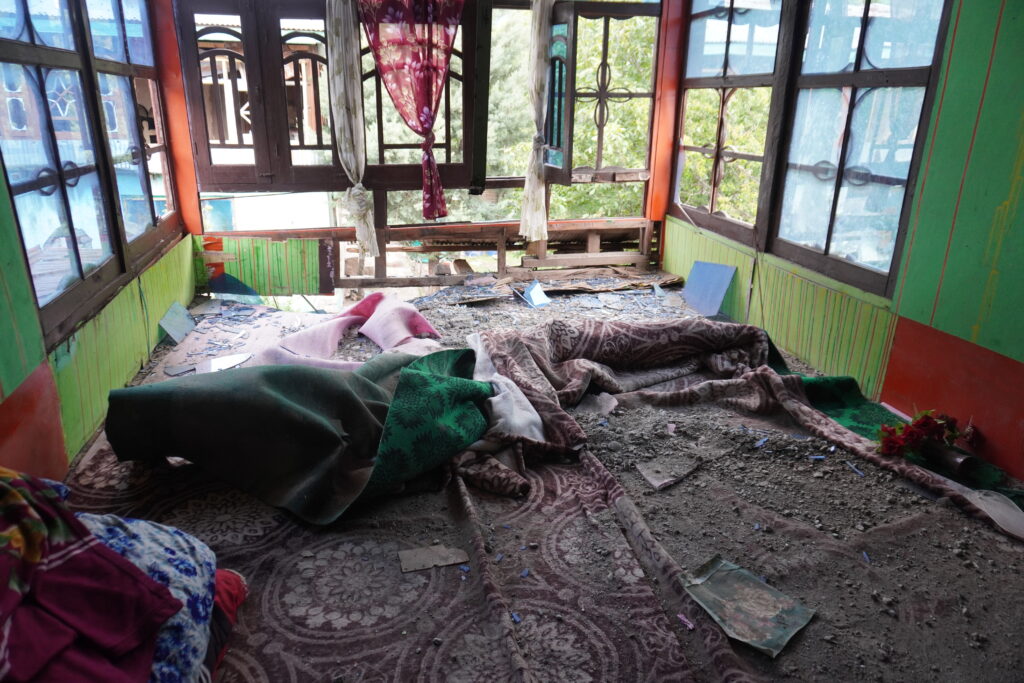
Zahida and her family are unsure how they will rebuild their lives. “Everyone from the local Members of Legislative Assembly to officials of the administration visited, but no real help has come,” said her brother-in-law. Four months after the war, the promised compensation is yet to come. And the compensation — Rs 30,000 for partial damage and Rs 1.5 lakh for full damage – is just not enough, say survivors.
“It’s not easy to rebuild what took us years to create,” said Zahida’s brother-in -law. “In the city, you might build a house for Rs 20 lakh, but here, it costs double because of the rough terrain and high transport costs. How can we rebuild with just Rs 1.5 lakh?” In that one week, Zahida and her family lost more than their home. They lost their sense of calm, peace, and their carefully constructed lives.
Living In Fear
The latest hostilities between India and Pakistan were the fourth in the long-standing geopolitical conflict between the two countries since 1947. It was sparked by a terrorist attack in Baisaran, Pahalgam, that killed 27 Indian tourists on April 22. The Indian army had announced ‘Operation Sindoor’ and Pakistan, in response, launched Operation Bunyanun Marsoos. For the first time, both countries engaged in drone warfare to target each other’s military bases.
During the escalation, Zahida’s neighbourhood came under intense shelling, destroying over a dozen houses. Geopolitical complexities have turned the region into one of the most militarised zones in the world: over seven lakh Indian armed personnel are stationed in Kashmir, and emergency laws such as the Armed Forces Special Powers Act led to many human rights violations.
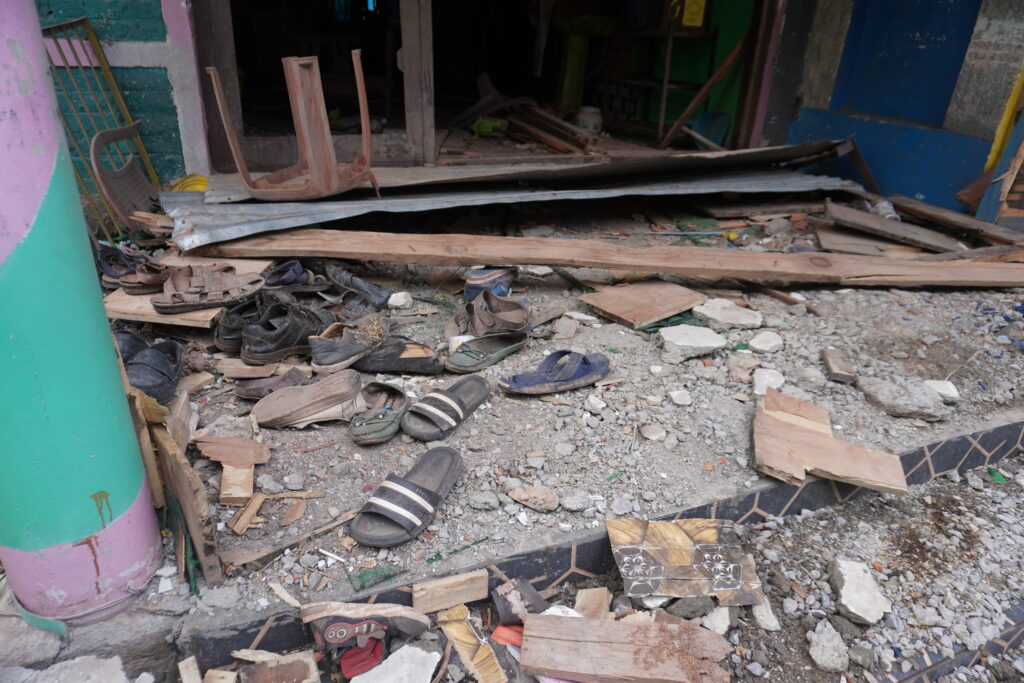
“There is a political problem in Kashmir that needs resolution. As long as that problem persists, incidents like this will continue to occur because the initiative lies with those who are part of the conflict, whether militants or individuals resisting security forces. Whenever they find an opportunity, they will strike,” said Ghazala Wahab, executive editor of Force magazine, who writes extensively on homeland security, terrorism, and Jammu and Kashmir.
Close to Zahida’s home, Rafiya Jan, 16, lives in a modest house she shares with her mother and elder sister. Her father, who died of electrocution eight months ago, had always been protective of his family and their home, a memory that weighs heavily on the women of the household. Their home was not directly hit by the shelling, but explosions shook the house.
“It felt like the walls were going to collapse,” Rafiya said. “We couldn’t sleep. We just held each other and prayed.” The family does not have a bunker.
When the shelling did not stop, Rafiya made an instant decision. “‘Let’s leave. Let’s walk towards the forest,” she said to her family. “They may target the houses but they’re not mad enough to waste ammunition on trees.”
That night, her whole family took shelter in the forest. At first light, they began to walk towards the main town of Uri, and from there, continued onward to Baramulla, 50 km away in search of safety.
When we met Rafiya Jan outside her home in June, she was chirpy and chatty. She told us how she loved wearing jewellery and lining her eyes with kohl. Until the conversation turned towards war. Her smile faded, her gaze dropped, and she fiddled with the metal ring on her index finger and the rim of her bangle.
“I hate stepping outside my home. Everywhere I look, I see the ruins of houses that once belonged to my friends, my relatives, my neighbors. It frightens me,” she said.
Nearly 200 km from Kalgi, Bushra Nabi*, 24, lives in the quiet village of Wuyan, on the outskirts of Pampore town. Though it is far from the Line of Control, Bushra’s world too is shaped by the same relentless undercurrents of fear and anxiety that war casts over the lives of Kashmiris.
On May 7, a drone strike shattered the fragile calm of Bushra’s neighborhood. In an instant, a private school was reduced to a heap of rubble. The ancient chinar tree that stood watch for generations was split in two, its branches scattered and charred.
“There was supposed to be a drill that day. So, when I heard the first shot, I thought it was just another routine exercise. But the sounds didn’t stop. They grew louder, closer. Suddenly, flames leapt all around us, spilling into the open,” she recalled.
She falls silent. When she speaks again, she barely manages a whisper. “The only thing I remember after that is all of us, huddled together, reciting ‘La e“ilaha illallah’, the sacred Quranic words Muslims recite when we believe the end has come.”
For months afterwards, Bushra and her family– parents and two brothers– huddled together in a single room every night. The fear has burrowed so deeply into their lives that even the smallest sounds outside–a stray dog barking, a branch snapping–would send waves of panic through the household.
This fear and alienation is all pervasive across Kashmir and goes back to the armed struggle staged by the separatists in the late 1980s, which saw militarised counter-insurgency operations by the Indian army. “We need to foreground how the Indian state itself has created the conditions for violence in Kashmir through its prolonged military occupation,” Hafsa Kanjwal, associate professor of history at Lafayette College, told Behanbox over email. “Rather than viewing the issue solely through the perspectives of India and Pakistan, this approach centers the everyday experiences of Kashmiris who face ongoing forms of violence at the hands of the Indian state and military.”
Patriarchy And Militarisation
Critical gender scholarship locates the experiences of Kashmiri women within a broader matrix of settler colonialism, militarised nationalism, and gendered control.
Samreen Mushtaq writes that ‘producing gendered forms of vulnerability has been characteristic of the militarised Indian state, which has for years, subjected Kashmiri women to varied forms of violence as a way of asserting control over Kashmir.’ Here, the line between occupation and personal violation becomes dangerously thin, and fear becomes a mechanism of control, eroding agency and softening the ground for more overt forms of violence.
“Sexualised violence is used strategically to undermine both personal dignity and communal identity, while political violence, through the targeting of land and the economy, broadens the spaces in which such harm can occur,” observes Angana Chatterji, a scholar at UC Berkeley who studies militarisation and gender in Kashmir, via email. “The ongoing conflict in Kashmir has created a landscape where Muslim Kashmiri women face heightened vulnerability to gendered and sexualised violence. Their bodies are often treated as cultural property, making them targets not just as individuals but as bearers of political and cultural identity.
Scholar Seema Kazi has documented how sexual violence in Kashmir is used as a tool to instill fear and punish dissent.
That normalisation of control and objectification was further laid bare in the aftermath of the abrogation of Article 370 in 2019, as comments from senior politicians like former Haryana Chief Minister Manohar Lal Khattar show. He had said that Kashmiri women could now be “brought for marriage,” framing them as demographic assets rather than individuals with rights and autonomy.
“Demonising Kashmiris and Muslims more broadly serves to consolidate Hindu majoritarian sentiments across India. The rhetoric of genocidal violence, and especially the threats of sexual violence directed at Kashmiri women, reveal a broader colonial dynamic at play,” said Hafsa Kanjwal.
But violence in Kashmir isn’t always visible or immediate. The killing or enforced disappearance of male kin, often working class, pushed many Kashmiri women into assuming the responsibility as earners and caregivers.
For many women, it takes the shape of slow erasure, forced migration, displacement, and legal exclusion. Women whose husbands have disappeared and are known as half-widows often lose access to land and inheritance, driving them into poverty and social isolation.
Resistance and Memory Keeping
“These days, the weather is harsh,” says Bushra Nabi. “Every evening brings a new storm, relentless rain, howling winds, sometimes even hail that batters our windows.” She pauses, recalling a night that still makes her hands tremble. “Just a few days ago, the wind picked up violently around three in the morning. Trees began to crash outside. I started shouting. I was certain it was happening again, that another attack had come for us in the darkness.”
Yet, Kashmiri women refuse to let their agency or history be erased as they resist through storytelling, songs, and collective action. Through political art like Hina Arif’s paintings of pellet victims, Naseem Shafaie’s verse that documents the intersecting burden of patriarchy and occupation, or the feminist collective Zanaan Wanaan’s rendition of Bella Ciao, Waliv Wathiv, Zaelim Chhun Kadun (“Rise up, throw out the tyrant”), written ‘on a stormy night’ after the abrogation of Article 370.
“When a community faces the threat of erasure, especially the erasure of their sense of history, memory is something they hold on to. Women have played an important role in this through the preservation of memory, whether it is through their storytelling, songs, or embodiment,” says Hafsa Kanjwal. “They have refused to allow the Indian state to define them as victims or to project itself as their savior.”
Parveena Ahangar turned her personal grief over the disappearance of her son into resistance and formed the Association of Parents of Disappeared Persons (APDP) that rallies women like her to look for the disappeared men in their families. Ather Zia, the anthropologist who spent a decade accompanying APDP activists, describes how their mourning is also a form of soft but unwavering politics. They adopt the cultural identity of ‘asal zanaan (good women)’, refusing to be portrayed as reckless agitators, while exercising crucial agency by entering courts, military checkpoints, mortuaries, and government offices on behalf of their missing men.
“Kashmiri women’s refashioning of self and notions of struggle for political freedom are drawn on elements from within their own culture,”’ writes Kashmiri scholar Inshah Malik.
“They resist through care, dissent, and solidarity, challenging gender conventions and refusing to be rendered docile”, says Angana. Writer-artist Uzma Falak introduced the concept of Vyestoan–affective female alliances that emerge during protests, demonstrations, and funeral processions of militants and civilians alike who are killed by the government forces, as gendered resistance.
Angana Chatterji frames solidarity not as sentiment, but as a radical political responsibility. “Solidarity with Kashmiri women across feminist, decolonial, and affective spaces requires women from/of India, especially those of Hindu descent, to examine normalised and majoritarian complicities.”
Uncertain Futures
In Kalgi village, 17-year-old Seema, who uses only her first name, sat on the veranda of her damaged home. The shattered window glasses have been sealed with polythene sheets to keep out the elements.
She spoke with fierce clarity, while her mother hovered nearby, occasionally stepping in to add a detail. Every word was carefully delivered as if it threatened to release the tears she was trying to contain.
Seema, a Class 10 student at a school in Salamabad, hadn’t returned to class since the attack. “My heart is broken,” she said. “Just look at our house. The fear hasn’t left us. Every time there’s a loud sound, we start running in all directions, knowing full well there’s nowhere truly safe.”
Seema’s mother built the house just a year ago with a bank loan of Rs 7 lakh with the support of a self-help group. “The debt still hangs over us,” she said, “We’re paying for a home that no longer exists, but will the bank understand?” Weary from repeated loss, she no longer sees any purpose in repairing their battered home. “What’s the use?” she asked.
The family’s anxiety is heightened by the absence of government-built bunkers in their village, leaving them exposed and vulnerable each night. With every distant rumble or sudden news of escalation, their fears return, haunted by the knowledge that, when violence comes again, they will have nowhere to hide and no guarantee of survival.
Seema’s father, a daily wage laborer, has little faith that any real help will come from the government. “There’s no point waiting, they don’t know, and they don’t care,” she said bluntly.
Post the abrogation of Article 370, the first elected government is largely a powerless one, with limited transfer of power from New Delhi to the local government. At the local government level, the District Development Council (DDC), introduced after the abrogation as a model of grassroots governance, faces the risk of quiet dismantling.
These changes in governance post-2019 also frame how security is managed in the region, said Mohmad Waseem Malla, Research Fellow at the International Centre for Peace Studies in New Delhi. This also explains Omar Abdullah’s tweet after the ceasefire was announced, which suggested that he had little knowledge of the management of the war. “While the Chief Minister may be informed, final decisions now fall within a centralised security grid led by the Union Home Ministry and military command, not the elected government. Unless full statehood is restored, the political leadership will remain peripheral to security deliberations and execution.”
But young dreams refuse to be subdued. For Iqra Jan, 18, hope itself is an act of courage. A resident of Srinagar, has the desires of an average teenager– freedom to meet friends without worry, travel fearlesslessly and nurture her ambition to become a doctor. But these can come only with a degree of stability and peace. “Sometimes I feel my exams are less about the syllabus and more about whether I’ll even be able to sit for them,” she said.
Ariba Bano, 15, also wants to finish school without interruptions and paint and write. “Every time classes stop, I feel like my future gets pushed further away,” she said in a soft tone.
We believe everyone deserves equal access to accurate news. Support from our readers enables us to keep our journalism open and free for everyone, all over the world.
